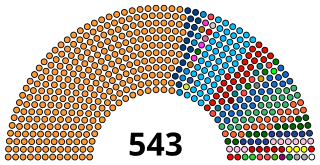Related Research Articles

The prime minister of India is the leader of the executive of the Government of India. The prime minister is the chief adviser to the President of India and the head of the Union Council of Ministers. They can be a member of any of the two houses of the Parliament of India—the Lok Sabha and the Rajya Sabha ; but has to be a member of the political party or coalition, having a majority in the Lok Sabha.

The president of India, is the ceremonial head of state of India and the commander-in-chief of the Indian Armed Forces.

The Lok Sabha, or House of the People, is the lower house of India's bicameral Parliament, with the upper house being the Rajya Sabha. Members of the Lok Sabha are elected by adult universal suffrage and a first-past-the-post system to represent their respective constituencies, and they hold their seats for five years or until the body is dissolved by the President on the advice of the council of ministers. The house meets in the Lok Sabha Chambers of the Sansad Bhavan, New Delhi.

A state of emergency is a situation in which a government is empowered to be able to put through policies that it would normally not be permitted to do, for the safety and protection of their citizens. A government can declare such a state during a natural disaster, civil unrest, armed conflict, medical pandemic or epidemic or other biosecurity risk. Justitium is its equivalent in Roman law—a concept in which the Roman Senate could put forward a final decree that was not subject to dispute yet helped save lives in times of strife.
In India, president's rule is the suspension of state government and imposition of direct central government rule in a state. Under Article 356 of the Constitution of India, in the event that a state government is unable to function according to constitutional provisions, the Central government can take direct control of the state machinery. Subsequently, executive authority is exercised through the centrally appointed governor, who has the authority to appoint other administrators to assist them. The administrators are usually nonpartisan retired civil servants.

In India, "The Emergency" refers to a 21-month period from 1975 to 1977 when Prime Minister Indira Gandhi had a state of emergency declared across the country. Officially issued by President Fakhruddin Ali Ahmed under Article 352 of the Constitution because of the prevailing "internal disturbance", the Emergency was in effect from 25 June 1975 until its withdrawal on 21 March 1977. The order bestowed upon the Prime Minister the authority to rule by decree, allowing elections to be suspended and civil liberties to be curbed. For much of the Emergency, most of Indira Gandhi's political opponents were imprisoned and the press was censored. Several other human rights violations were reported from the time, including a mass forced sterilization campaign spearheaded by Sanjay Gandhi, the Prime Minister's son. The Emergency is one of the most controversial periods of independent India's history.
Lawmaking procedure in India gives a brief description about the legal system in India.
The basic structure doctrine is an Indian judicial principle, most notably propounded by Justice Hans Raj Khanna, that the Constitution of India has certain basic features that cannot be altered or destroyed through amendments by the parliament. Key among these "basic features", as expounded by Justice Khanna, are the fundamental rights guaranteed to individuals by the constitution. The doctrine thus forms the basis of a power of the Supreme Court to review and strike down constitutional amendments and acts enacted by the Parliament which conflict with or seek to alter this "basic structure" of the Constitution. The basic features of the Constitution have not been explicitly defined by the Judiciary, and the claim of any particular feature of the Constitution to be a "basic" feature is determined by the Court in each case that comes before it. Thus it gives extra power to court to review and strike down any constitutional amendments and act enacted by the Parliament.
The Maintenance of Internal Security Act (MISA) was a controversial law passed by the Indian parliament in 1971 giving the administration of Prime Minister Indira Gandhi and Indian law enforcement agencies very broad powers – indefinite preventive detention of individuals, search and seizure of property without warrants, and wiretapping – in the quelling of civil and political disorder in India, as well as countering foreign-inspired sabotage, terrorism, subterfuge and threats to national security. The law was amended several times during the subsequently declared national emergency (1975–1977) and used for quelling political dissent. Finally it was repealed in 1977, when Indira Gandhi lost the 1977 Indian general election and the Janata Party came to power.
The Thirty-ninth Amendment of the Constitution of India, enacted on 10 August 1975, placed the election of the President, the Vice President, the Prime Minister and the Speaker of the Lok Sabha beyond the scrutiny of the Indian courts. It was passed during the Emergency of 1975–1977. It was moved by the Congress government headed by Indira Gandhi to preempt a hearing by Supreme Court of India concerning the setting aside of Gandhi's election by the Allahabad High Court on the grounds of corrupt electoral practices.
Satyendra Narayan Sinha was an Indian statesman, participant in the Indian independence movement, a leading light of Jaya Prakash Narayan’s ‘complete revolution’ movement during the Emergency and a former Chief Minister of Bihar. Affectionately called Chhote Saheb, he was also a seven-time Member of Parliament from the Aurangabad constituency, a three-term Member of the Bihar Legislative Assembly, and a Member of the Bihar Legislative Council once. Regarded to be one of India's most influential regional people of the time, his reputation was synonymous with being a strict disciplinarian and tough taskmaster.
Vidya Charan Shukla was a noted Indian politician and Minister from the Indian National Congress party. His political career spanned almost six decades. He was a close associate of Indira Gandhi.

The 42nd amendment, officially known as The Constitution Act, 1976, was enacted during the Emergency by the Indian National Congress government headed by Indira Gandhi.

In a major turn of events, the ruling Congress lost control of India for the first time in independent India in the Indian general election, 1977. The hastily formed Janata alliance of parties, opposed to the ruling Congress party, won 298 seats. Morarji Desai was chosen as the leader of the alliance in the newly formed parliament and thus became India's first non-Congress Prime Minister on 24 March. The Congress lost nearly 200 seats. Prime Minister Indira Gandhi and her powerful son Sanjay Gandhi both lost their seats.

The Twenty-fifth Amendment of the Constitution of India, officially known as The Constitution Act, 1971, curtailed the right to property, and permitted the acquisition of private property by the government for public use, on the payment of compensation which would be determined by the Parliament and not the courts. The amendment also exempted any law giving effect to the article 39(b) and (c) of Directive Principles of State Policy from judicial review, even if it violated the Fundamental Rights.

The Representation of the People Act, 1951 is an act of Parliament of India to provide for the conduct of election of the Houses of Parliament and to the House or Houses of the Legislature of each State, the qualifications and disqualifications for membership of those Houses, the corrupt practices and other offences at or in connection with such elections and the decision of doubts and disputes arising out of or in connection with such elections. It was introduced in Parliament by law minister Dr. B.R. Ambedkar. The Act was enacted by the provisional parliament under Article 327 of Indian Constitution, before the first general election.
The Andhra Pradesh Reorganisation Act, 2014, popularly known as the Telangana Act, is an Act of Indian Parliament that bifurcated the state of Andhra Pradesh into Telangana and the residuary Andhra Pradesh state, as an outcome of the Telangana movement. The Act defined the boundaries of the two states, determined how the assets and liabilities were to be divided, and laid out the status of Hyderabad as the permanent capital of new Telangana state and temporary capital of the Andhra Pradesh state.

The Twenty-fourth Amendment of the Constitution of India, officially known as The Constitution Act, 1971, enables Parliament to dilute Fundamental Rights through Amendments of the Constitution. It also amended article 368 to provide expressly that Parliament has power to amend any provision of the Constitution. The amendment further made it obligatory for the President to give his assent, when a Constitution Amendment Bill was presented to him.
The Parliament of India is bicameral. Concurrence of both houses are required to pass any bill. However, the makers of the Constitution of India anticipated situations of deadlock between the upper house that is Rajya Sabha and the lower house i.e. Lok Sabha. Therefore, the Constitution of India provides for Joint sittings of both the Houses to break this deadlock. The joint sitting of the Parliament is called by the President and is presided over by the Speaker or, in his absence, by the Deputy Speaker of the Lok Sabha or in his absence, the Deputy-Chairman of the Rajya Sabha. The Chairman doesn't preside over the joint session at any means/cost. If any of the above officers are not present then any other member of the Parliament can preside by consensus of both the House.

The Forty-third Amendment of the Constitution of India, officially known as the Constitution Act, 1977, repealed six articles that had been inserted into the Constitution by the 42nd Amendment which had been enacted by the Indira Gandhi-led Indian National Congress during the Emergency. The 43rd Amendment was enacted by the newly elected Janata Party which had won the 1977 general elections campaigning on a promise to "restore the Constitution to the condition it was in before the Emergency".
References
- 1 2 Bari, M. Ehteshamul (2017). States of Emergency and the Law: The Experience of Bangladesh. Routledge. pp. 62–64. ISBN 9781351685917.
- ↑ http://www.indiankanoon.org/doc/1018568/
- ↑ D'Souza, Jos Peter (June 2001). "When the Supreme Court Struck Down the Habeas Corpus". A D M Jabalpur vs. Shukla.